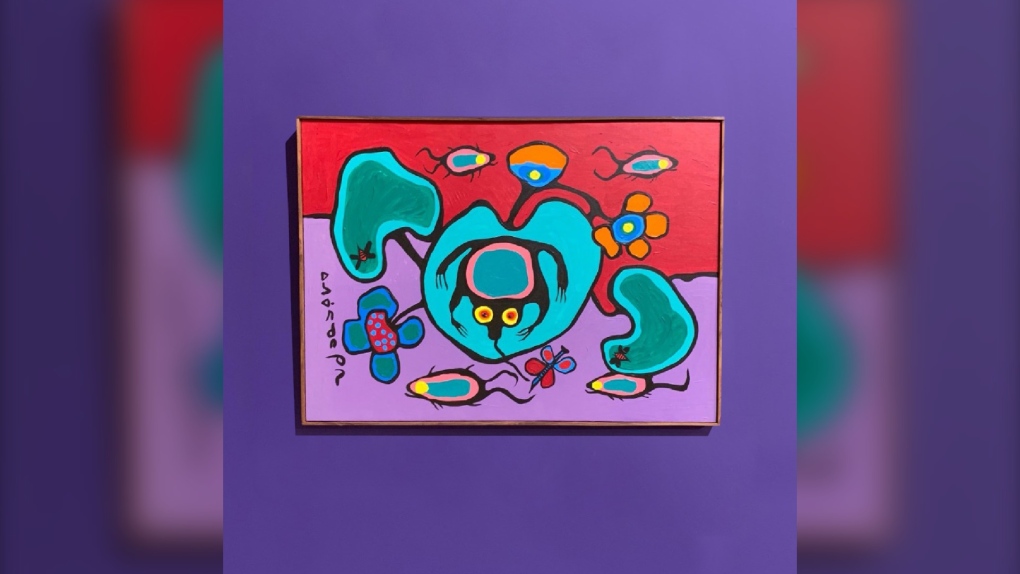Another man pleads guilty in mass forgery of Norval Morrisseau's artworks
 More than 1,000 alleged fraudulent artworks purported to be painted by Norval Morrisseau were seized following a decades-long investigation. (Christian D’Avino/CTV News)
More than 1,000 alleged fraudulent artworks purported to be painted by Norval Morrisseau were seized following a decades-long investigation. (Christian D’Avino/CTV News)
A key player in a massive art fraud scheme oversaw an "assembly line"-like production of fake Norval Morrisseau paintings, court heard Tuesday, as the Thunder Bay, Ont., man pleaded guilty to two charges.
David Voss, 52, pleaded guilty to one count of forgery and one count of uttering forged documents. An agreed statement of facts filed with the court said Voss oversaw the creation and distribution of thousands of forged Morrisseau artworks from 1996 to the mid-2010s.
Morrisseau, also known as Copper Thunderbird, was a trailblazer for contemporary Indigenous artists across Canada and had received numerous awards and honours, including the Order of Canada. He died in 2007.
A Thunder Bay courtroom heard Tuesday that Voss initially forged Morrisseau artworks on his own, but his operation later "grew to resemble an assembly line in which multiple painters assisted."
Those painters and other witnesses interviewed by police described a process in which Voss would draw an outline of a painting in pencil and then use a letter-coded system to indicate how the artwork should be painted -- G for green, B for blue and so on.
 A painting by Norval Morrisseau, on display in the Art Gallery of Algoma's virtual exhibit. April 26/2020 (Christian D'Avino/CTV News Northern Ontario)
A painting by Norval Morrisseau, on display in the Art Gallery of Algoma's virtual exhibit. April 26/2020 (Christian D'Avino/CTV News Northern Ontario)
"The painters were paid to apply the paint in accordance with this 'paint-by-numbers' process," the statement of facts said, noting that forensic analysis of some of those paintings later revealed the underlying letter codes and pencil markings.
Court heard that Voss eventually abandoned this system and returned to producing fake Morrisseau paintings on his own. He also applied Morrisseau's name in Cree syllabics on the front of the artwork and a dry-brush English signature on the back, according to the court document.
Court heard that more than 1,500 so-called "Voss ring" forgeries have been identified to date but an unknown number of them remain in circulation.
Forgeries sold to distributors
The forgeries were consigned or sold by Voss to distributors and auction houses across Canada "where they were purchased by unsuspecting members of the public," the agreed statement of facts said, adding that Voss told purchasers he had obtained the artwork either directly or indirectly from Morrisseau.
Eight people were initially charged last year in what's been described as one of the largest art fraud investigations in the world.
Another key figure in the case, Thunder Bay resident Gary Lamont, pleaded guilty to two charges and was handed a five-year sentence in December.
Lamont knew Morrisseau personally for 30 years and the artist had occasionally given him some of his original artwork.
But from 2002 onwards, Lamont oversaw production of "hundreds of artworks" that were falsely attributed to Morrisseau and that carried forged signatures associated with the artist, court heard at the time.
When Lamont was sentenced, the Morrisseau estate said in a statement that the art fraud had a massive financial and emotional toll, diminishing the value of the artist's original paintings and tarnishing the reputation of the Morrisseau family.
This report by The Canadian Press was first published June 5, 2024.
CTVNews.ca Top Stories

Trudeau's 2024: Did the PM become less popular this year?
Justin Trudeau’s numbers have been relatively steady this calendar year, but they've also been at their worst, according to tracking data from CTV News pollster Nik Nanos.
Manhunt underway after woman, 23, allegedly kidnapped, found alive in river
A woman in her 20s who was possibly abducted by her ex is in hospital after the car she was in plunged into the Richelieu River.
Death toll in attack on Christmas market in Germany rises to 5 and more than 200 injured
Germans on Saturday mourned both the victims and their shaken sense of security after a Saudi doctor intentionally drove into a Christmas market teeming with holiday shoppers, killing at least five people, including a small child, and wounding at least 200 others.
Overheated immigration system needed 'discipline' infusion: minister
An 'overheated' immigration system that admitted record numbers of newcomers to the country has harmed Canada's decades-old consensus on the benefits of immigration, Immigration Minister Marc Miller said, as he reflected on the changes in his department in a year-end interview.
Toronto firefighters rescue man who fell into sinkhole in Yorkville
A man who fell into a sinkhole in Yorkville on a snowy Friday night in Toronto has been rescued after being stuck in the ground for roughly half an hour.
Wild boar hybrid identified near Fort Macleod, Alta.
Acting on information, an investigation by the Municipal District of Willow Creek's Agricultural Services Board (ASB) found a small population of wild boar hybrids being farmed near Fort Macleod.
Summer McIntosh makes guest appearance in 'The Nutcracker'
Summer McIntosh made a splash during her guest appearance in The National Ballet of Canada’s production of 'The Nutcracker.'
The winter solstice is here, the Northern Hemisphere's darkest day
The winter solstice is Saturday, bringing the shortest day and longest night of the year to the Northern Hemisphere — ideal conditions for holiday lights and warm blankets.
22 people die in a crash between a passenger bus and a truck in Brazil
A crash between a passenger bus and a truck early Saturday killed 22 people on a highway in Minas Gerais, a state in southeastern Brazil, officials said.
































